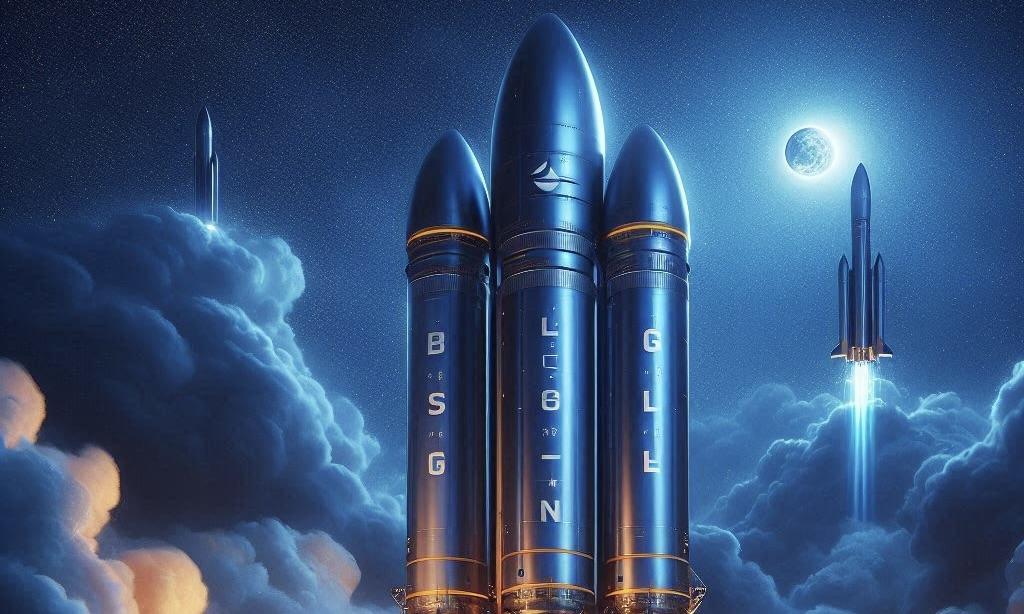Blue Origin is making significant strides toward testing its New Glenn rocket, designed to compete with SpaceX’s Falcon lineup. With seven BE-4 engines producing 3.8 million pounds of thrust, the New Glenn is set to test its heavy-lift capabilities with a key fire test, positioning it as a strong contender in the space race.
Blue Origin’s New Glenn Rocket Set to Rival Falcon Heavy with Superior Thrust and Reusability
Blue Origin, Jeff Bezos' rocket company, is steadily moving closer to testing its New Glenn rocket in a fire for the first time. Like SpaceX's Falcon 9, the missile, propelled by internal engines, is intended to land on a ship. Video from Florida shows Blue Origin's barge returning to port at Cape Canaveral late on November 8 night after completing offshore testing, demonstrating that New Glenn is also more powerful than SpaceX's operational Falcon 9. With a significant fire test of its engines anticipated shortly, this return represents another milestone in the rocket's test program.
With seven BE-4 engines producing 3.8 million pounds of thrust, the New Glenn rocket has more than double the power of SpaceX's Falcon 9, with nine Merlin 1D engines producing 1.7 million pounds of thrust. New Glenn, positioned as a heavy-lift rocket, competes with SpaceX's Falcon Heavy. This far more potent craft generates 5.1 million pounds of thrust with three boosters and 27 Merlin 1D engines.
The single rocket from New Glenn is made to be fully reusable, just like the Falcon 9 and Falcon Heavy boosters. Blue Origin has finished a series of offshore tests on its barge in preparation for an expected fire test before the end of the year. The business intends to land the booster on a barge at sea. According to footage from the local media, these tests involved a helicopter and were related to communication checks.
Because of its size, the New Glenn's first-stage booster is anticipated to be more challenging to land than the Falcon 9's. If Blue Origin is successful, the New Glenn will be the first heavy-lift vehicle to land a ship successfully.
Blue Origin’s New Glenn Rocket Prepares for Key Fire Test After Engine Installations
To prepare for the fire test, Blue Origin spent a significant portion of October installing the rocket's seven BE-4 engines, making October a busy month for the New Glenn rocket. Some of the BE-4s on the New Glenn can gimbal, which enables them to move around a central point to control the rocket during ascent and recovery aboard Blue Origin's recovery ship, Jacklyn. This capability is similar to that of SpaceX's Merlin engines.
Following the installation of the engines, the New Glenn was relocated from Blue Origin's facilities to Cape Canaveral Space Force Station's Launch Complex 36 in Florida. According to CEO Dave Limp, the next stage of New Glenn's campaign will be an integrated launch vehicle fire, where the first stage's engines will be briefly ignited, and the second stage will be stacked on top of the first stage booster. Blue Origin conducted a similar test on the BE-3U engines used in the second stage in late September.
The BE-3U engines fired up for the fire test, the first-time flight hardware was employed. In contrast to the BE-4 engines, which use methane for easier handling, the BE-3Us use liquid hydrogen as their fuel. In addition to launching portions of Amazon's Kuiper low Earth orbit satellite internet constellation, New Glenn is a crucial part of Blue Origin's plans because it will launch NASA's Blue Moon lander, which is contracted to assist in the landing of humans on the Moon as part of the Artemis program.



 CDC Vaccine Review Sparks Controversy Over Thimerosal Study Citation
CDC Vaccine Review Sparks Controversy Over Thimerosal Study Citation  NASA Resumes Cygnus XL Cargo Docking with Space Station After Software Fix
NASA Resumes Cygnus XL Cargo Docking with Space Station After Software Fix  Trump and Merck KGaA Partner to Slash IVF Drug Costs and Expand Fertility Coverage
Trump and Merck KGaA Partner to Slash IVF Drug Costs and Expand Fertility Coverage  Ancient Mars may have had a carbon cycle − a new study suggests the red planet may have once been warmer, wetter and more favorable for life
Ancient Mars may have had a carbon cycle − a new study suggests the red planet may have once been warmer, wetter and more favorable for life  SpaceX Reportedly Preparing Record-Breaking IPO Targeting $1.5 Trillion Valuation
SpaceX Reportedly Preparing Record-Breaking IPO Targeting $1.5 Trillion Valuation  NASA Astronauts Wilmore and Williams Recover After Boeing Starliner Delay
NASA Astronauts Wilmore and Williams Recover After Boeing Starliner Delay  Tabletop particle accelerator could transform medicine and materials science
Tabletop particle accelerator could transform medicine and materials science  FDA Pilot Program Eases Rules for Nicotine Pouch Makers
FDA Pilot Program Eases Rules for Nicotine Pouch Makers  noyb Files GDPR Complaints Against TikTok, Grindr, and AppsFlyer Over Alleged Illegal Data Tracking.
noyb Files GDPR Complaints Against TikTok, Grindr, and AppsFlyer Over Alleged Illegal Data Tracking.  Moore Threads Stock Slides After Risk Warning Despite 600% Surge Since IPO
Moore Threads Stock Slides After Risk Warning Despite 600% Surge Since IPO  Intel’s Testing of China-Linked Chipmaking Tools Raises U.S. National Security Concerns
Intel’s Testing of China-Linked Chipmaking Tools Raises U.S. National Security Concerns  Trump Signs Executive Order to Boost AI Research in Childhood Cancer
Trump Signs Executive Order to Boost AI Research in Childhood Cancer  iRobot Files for Chapter 11 Bankruptcy Amid Rising Competition and Tariff Pressures
iRobot Files for Chapter 11 Bankruptcy Amid Rising Competition and Tariff Pressures  Trump Signs Executive Order to Establish National AI Regulation Standard
Trump Signs Executive Order to Establish National AI Regulation Standard 































